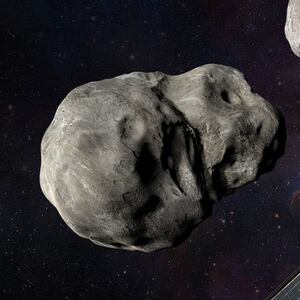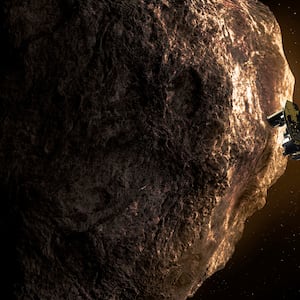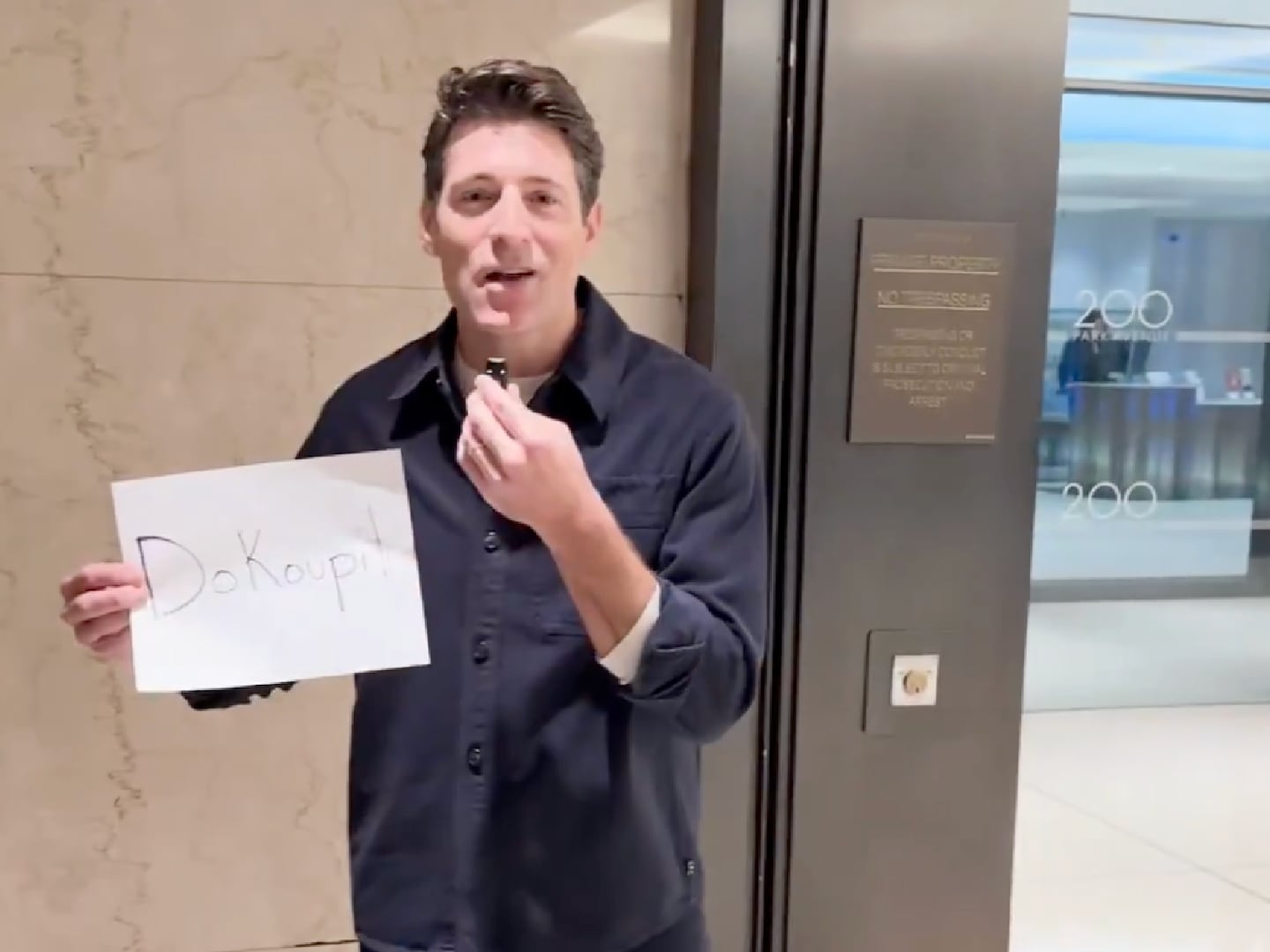In Moonfall, director Roland Emmerich’s latest disaster movie, the moon attacks Earth—something we can all agree would be bad news for our home planet. Luckily, as is often the case in space-disaster blockbusters, we have some heroic astronauts and all of NASA’s resources ready to save the day, even if some landmarks get destroyed in the process. The scale of Moonfall’s destruction might be bigger than past films like Armageddon or the recent Don’t Look Up, but the heroes remain the same. In the movies, we can always count on NASA to beat the odds and save the day. It’s a good look for the agency. But how much of this popcorn idea of NASA as our heroic planetary sentinel is based in reality? Do movies like Moonfall burnish or exaggerate NASA’s image?
Casey Dreier, the senior space policy adviser at the Planetary Society, told The Daily Beast it’s clear that pop culture has helped shape public perception of NASA. It’s easy to forget that the Apollo missions were not especially popular in their time. It was only later, spurred in no small part by the glow of films like Apollo 13 and even more outlandish fare like Armageddon and Deep Impact, that the general public began to look at NASA fondly and with admiration.
“NASA’s kind of the stand-in for competence, creativity, ambition, and ability. It’s kind of tied up with being rocket scientists,” Dreier said. “It’s the one federal agency consistently given so many positive representations in movies. Like, you certainly don’t see that happening with the Department of Agriculture.”
To be fair, even the most imaginative threat the Department of Agriculture might have to deal with would likely pale in comparison to a space-based threat. In Moonfall, the moon is revealed to be some sort of nanobot-infested alien megastructure that suddenly veers out of orbit and comes crashing into Earth. (In reality the moon was a byproduct of a massive collision with Earth itself, billions of years ago).
But the movie does get right the actual broad consequences of an incoming rock of that magnitude. Tides will be huge, the planet’s orbit will speed up, and its axis will go berserk. Eventually, when Earth’s gravity is stronger than the gravity holding the moon together, the gray desolate body will start to break apart and rain death and destruction down on Earth.
In Moonfall, a pair of heroic astronauts and a vindicated conspiracy theorist take charge of NASA’s efforts to stop the moon from destroying the planet. NASA as a whole doesn’t exactly save the day (and as is often the case in a moon-related sci-fi movie, higher-ups at the organization are complicit in a cover-up), but you get the sense in the film that NASA calls the shots to a certain extent, and that there is no way that the moon would’ve been—spoiler alert—stopped, without NASA. Shoutout to NASA.
NASA is well aware of the power that pop culture has in shaping public opinion, as the agency works with dozens of movies and TV shows every year. Sometimes it’s simply providing video assets, while in other instances the agency will provide experts to consult on science or history. This was the case with Moonfall, as Jim Green, NASA’s former chief scientist, met with some producers to talk about the physics of a too-close-for-comfort moon.
Bert Ulrich, NASA’s multimedia liaison for movies and TV, told The Daily Beast that the agency collaborates with filmmakers in an attempt to “tell some of NASA’s story of what we’re doing as well, trying to help inform the public of what NASA’s all about.” While something like First Man, a historical biopic about Neil Armstrong, does a pretty straightforward job of informing the public about NASA’s mission, even something as ridiculous as Moonfall has merit.
“Some of these movies are very inspirational, very exciting for the agency,” he said. “We are very lucky that we have filmmakers who are interested in working with us and sharing NASA’s story in interesting ways even if they’re really fictional.”
Everybody the Daily Beast spoke to also noted that sci-fi, even fantastical stuff like Star Trek, is often a reason why people get interested in space exploration and grow up to work with NASA in the first place.
NASA doesn’t participate in every single movie about space—and indeed, directors are free to make movies and use the NASA name without the agency’s approval. Ulrich cited the 2017 Jake Gyllenhaal and Ryan Reynolds horror flick Life as an example of a movie NASA didn’t take part in “because it was a screamer. It just wasn’t appropriate for NASA to be a part of that.” Moonfall, though, got the NASA buy-in because of “the tone of the story and the willingness of Roland Emmerich to work with us to sort of have a scenario that NASA could live with if we were to participate.”
Finding and responding to potential threats to the planet is very much part of NASA’s mission, though the movies might give an outsized expectation of exactly what capabilities Houston would have in a Moonfall situation—or even a more reasonable world-ending disaster.
“I'd say they definitely exaggerate NASA’s role,” Dreier said of Moonfall and other space disaster movies. “NASA doesn’t have a lot of responsibilities formally within the national defense structure or the U.S. government on a whole. It's not like NASA’s a cabinet-level position.”
Tellingly, NASA is run by an administrator, but many movies—including Moonfall—misidentify the head honcho as a more decisive-sounding director. While NASA would certainly be involved in a Moonfall scenario, Dreier said they wouldn’t be directing the response.
“NASA would be a tool of resource of expertise and information, and what to do then becomes a broader political choice,” Dreier said. “So the moon is, like, falling out of the sky and is attacking us? I'm sure NASA could do the calculations about when it's gonna hit, how much of a destructive consequence it would be, and potentially ways to deflect it or stop it based on the tools, technologies, and capabilities we have around. They would then probably tell the White House, ‘This is what we could do.’”
And what NASA could do if the literal moon were to attack the Earth is, to be honest, not much. Green, who contributed some science advice to the film, told The Daily Beast anything that stopped a rampaging moon—itself a violation of physics—probably involved “even more unbelievable physics.”
“I think expectation-setting is something to be aware of,” Dreier said, acknowledging that some movies give the false impression that NASA can “just throw together a Star Trekian-type of spacecraft that you can just hammer together in a couple of months and then access any part of the solar system you need.”
“You may be throwing people’s imaginations off when Bruce Willis is standing on the surface of a blazing asteroid and drilling a hole to put a nuke in it, or whatever happens in Armageddon, but in that same sentence, you understand that there is such a thing as an asteroid,” Andrew Sloan, creative director and founder of the space branding agency Cosma Schema, told The Daily Beast. “They do pose a threat to Earth. There are things that you learn along the way that are worth investigating.”
While a lunar assault is thankfully beyond the pale, NASA is hard at work tracking much smaller heavenly bodies—asteroids that could do serious damage to the planet even if they’re a fraction of the moon’s size. Organizations like the Center For Near-Earth Object Studies have found a little less than half of an estimated 60,000 asteroids that could threaten Earth one way or another. Experiments like the Double Asteroid Redirection Test (DART) Mission, which will aim to change the trajectory of a (non-threatening) asteroid, are the nascent real-world equivalents of Moonfall’s fanciful planet-saving.
Green, who said he happily “checks his science at the door” when he sees a movie like Moonfall, thinks the film’s depiction of heroic moon-fighting astronauts is great because there’s truth underneath all the exaggeration.
“NASA literally found something that is an existential threat to the Earth and we’re doing something about it. That’s our mission,” he said. “So, portraying aspects that allow the public to be curious about what NASA’s doing is only a good thing.”
Drier echoed those sentiments: “I’d rather have NASA be the mythical symbol of competence, sensibility, trust, and success than the opposite— NASA being a poster child for failure, project mismanagement, under-budgeting, and historical failure. I’ll take the side consequence of people having too much faith and trust in NASA than the other way around.”
In other words, it doesn’t hurt if the public believes that NASA can take on the world—or the moon, in this case.








